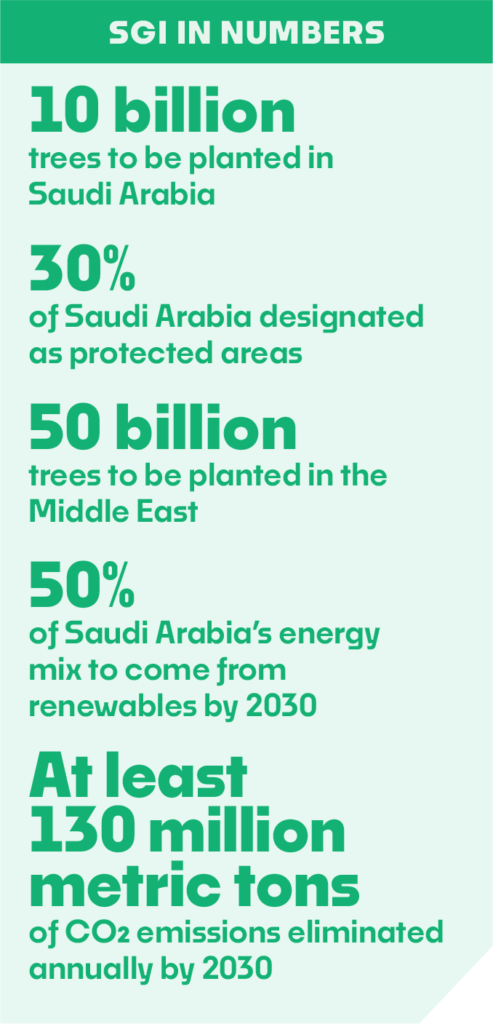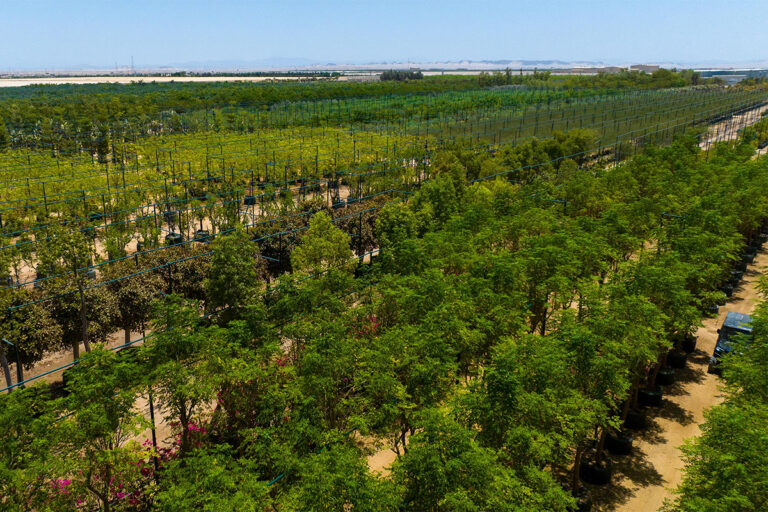
Saudi Arabia has launched two green initiatives that will preserve ecosystems and transform the environment in the Middle East and beyond.
As global leaders count down to the landmark COP26 conference on climate change, the world’s largest energy exporter is spearheading efforts to accelerate the energy transition, reduce greenhouse gas emissions, and protect wildlife and environmental resources across the Middle East.
 Earlier this year, Saudi Arabia launched the Saudi Green Initiative, which will plant 10 billion trees in the country over the coming decades. The ambitious environmental initiative will multiply the area of Saudi Arabia covered by trees by a factor of 12, equivalent to rehabilitating 40 million hectares of degraded land.
Earlier this year, Saudi Arabia launched the Saudi Green Initiative, which will plant 10 billion trees in the country over the coming decades. The ambitious environmental initiative will multiply the area of Saudi Arabia covered by trees by a factor of 12, equivalent to rehabilitating 40 million hectares of degraded land.
The Saudi Green Initiative will not only increase vegetation cover and fight desertification, it will also focus on reducing carbon emissions, combatting pollution, and the protection and repopulating of wildlife.
The country’s ambitions for a greener future do not end at its own borders; Saudi Arabia has also unveiled a far-reaching Middle East Green Initiative that will see the planting of an additional 40 billion trees across the region. This international effort to restore an area equivalent to 200 million hectares of degraded land is the world’s largest reforestation program, projected to reduce global carbon levels by 2.5%.
By sharing best practices, stimulating investment, and tracking progress toward targets, the Middle East Green Initiative also aims to reduce carbon emissions from hydrocarbon production in the region by more than 60%.

Setting the pace for renewables in the Middle East, Saudi Arabia is already ramping up projects, particularly in solar and wind. At the same time, it is implementing energy efficiency programs, investing in low-carbon public transportation such as high-speed rail lines, and developing cutting-edge technologies including carbon capture and green hydrogen production. By 2030, at least 50% of the country’s energy mix will be drawn from renewables.
“The Kingdom’s strong commitment to tackle biodiversity loss and land degradation, invest in nature-based solutions, and protect the environment is an important contribution to international efforts to combat environmental challenges.”
Inger Andersen, Under-Secretary-General of the United Nations and Executive Director of the UN Environment Programme
In October, to continue the momentum, the country is hosting the Saudi Green Initiative Forum, where it will unveil its roadmap for meeting its climate targets and tracking its performance in the fight against climate change.
The forum will be followed by the Middle East Green Initiative Summit, where international and regional leaders will collaborate on climate change solutions, working to ensure a sustainable future for all. A Youth Green Summit will also be held to help incubate the next generation of leadership in environmental stewardship.

Protecting natural treasures
As part of the Saudi Green Initiative’s formidable environmental commitment, more than 30% of the total territory of the Kingdom—230,000+ square miles—will be designated as protected areas. This also includes a focus on the country’s biodiverse coastal regions and its dazzling coral reefs, which are threatened by the rise in sea temperatures caused by climate change.
Saudi Arabia is accelerating its efforts to preserve its unique ecosystems both on land and in the sea. Over the past four years, the percentage of the Kingdom’s protected natural reserves has increased from 4% to more than 16%, and 75 additional land, coastal, and marine areas are proposed for further protection. In 2020 alone, the country planted more than 2 million mangrove trees along thousands of miles of coastline. Mangrove forests are rich carbon sinks and serve as a nursey for many marine animals.

Meanwhile, new populations of celebrated desert animals such as gazelle, oryx, and ostrich are being carefully reintroduced to their native Saudi environment.
To support these rewilding efforts, Saudi Arabia will increase the size of its new force of special environmental guards by almost tenfold over the next four years. There are also plans to reintroduce animals such as the Arabian leopard—currently extinct in the wild in Saudi Arabia—back into its ancestral home, instilling reverence for the past and sowing hope for our collective future![]()









